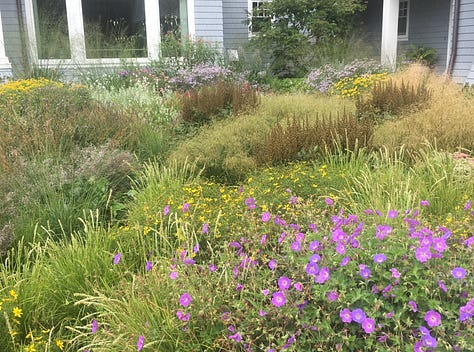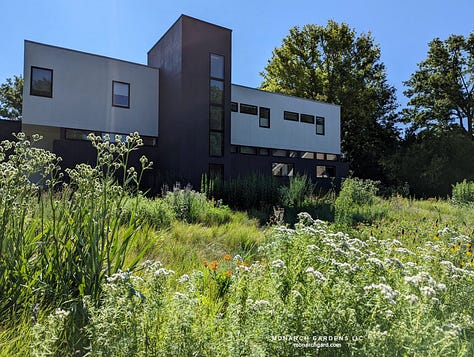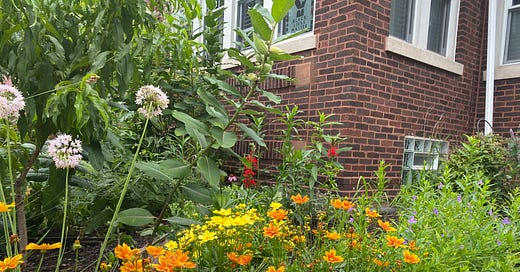Hey! Thanks for coming to my tedious TedTalk over the past couple weeks about wealth, travel, colonialism, and climate change! I often describe myself as a professional wet blanket for a reason.
As an addendum, I’d like to reiterate that no one individual is responsible for, or going to solve, the climate crisis, obviously. Which is why, what I’d like to see even more than the global 1% scaling back their consumption-oriented lives, is economic degrowth policies and plans enacted in all the wealthiest countries in the world. That way, we’re all in it together (whether we like it, or not) and we can more effectively shrink the resource gap between the rich and the poor. I’m not naive enough to think that most economically privileged people will simply stop buying whatever they want or doing whatever they want just because it’s the more ecologically sound choice.
But, I don’t expect we’ll enact the policies we really need if we can’t (or won’t) properly identify the problem, which is not actually traveling to Thailand for vacation with your wealthy and unscrupulous husband, father, or boyfriend, per se (White Lotus reference, folks). It’s the recognition of just how wildly resource-intensive some of our lives are, at great expense to people and planet, because we’ve built an economic system in which that’s the intended outcome.
It just so happens that a terrific Substack/podcast, Planet: Critical, covered all this stuff I just wrote about in a podcast last week. Check out “The ‘Energy Transition’ is a Pipe Dream” if you want to hear two smart people talking real talk on energy and resource consumption.
Honestly, when I think about how incomprehensibly complex and interconnected our lives are, relying on labor and resources from all over the globe just to get through our daily tasks, whether it’s making a cup of coffee or sending an email, it’s a wonder this whole societal Jenga game hasn’t come crashing down already.
Anyway, on to native plants!
One of the concepts that has stuck with me from Jenny Odell’s brilliant book How to Do Nothing is bioregionalism. Broadly, it’s a philosophy that suggests our culture, economy, and, according to Odell, even attention, is best organized around the bioregions in which we live - the shared watersheds, topographies, geographies, flora, and fauna of particular regions of the planet. For Odell, it was primarily getting into bird watching that got her thinking about bioregionalism, and feeling more connected to the specific land and region she lived in. The philosophy resonates with me as someone who thinks artificially drawn borders, violently enforced, often do more harm than good; but also as someone who’s been thinking about how to responsibly steward the little patch of land I’m lucky enough to call my yard.
For those of us who live a modern, Western lifestyle, bioregionalism is a foreign concept. We often live completely disconnected from the land we’re on, with our air conditioned homes and landscaped yards and parks. A U.S. Department of Interior study (that of course, I can’t find now because it’s probably been taken down) from years ago found that the average American kid can identify 1000 corporate logos, but only 10 plant and animal species native to their region. I can’t imagine many adults would fare much better, to be honest. (Though 1000 corporate logos seems like an awful lot, doesn’t it? In fact, these numbers seem a bit too round for me to not take with a bit of a grain of salt; but I have full confidence that the conclusion - that we’re way more attuned to our corporate environment than our physical environment - is fully accurate.)
I’ve already written about biodiversity loss, but the news just keeps coming. The latest is the catastrophic decline in butterfly populations in the U.S. due to climate change, habitat loss, and insecticides. The scientists involved in this study point out that similar declines are probably happening to other insect species. “The tree of life is being denuded at unprecedented rates,” said one of the scientists. I always feel like I need to point out, because somebody might say who cares about butterflies? that if we keep weakening and snipping strands in the web of life, the whole thing will eventually fall apart, and we may well take ourselves with it. Wouldn’t be the first time a mass extinction event wiped out nearly every living thing on the planet.
The first couple years we were in our house, I just planted pretty flowers without thinking much about it. I don’t remember how I got into native gardening, but slowly I morphed my gardening approach from “pretty” to “plants native to my bioregion that are suited to this particular part of my yard.” A bit more of a specific mission. Not that there’s anything wrong with pretty flowers, and not that native plants can’t also be pretty flowers (in fact, many of them are).
I’ve kept up with it because it makes me happy and brings more birds and insects to my yard. Native plants, if they’re well-suited to their site conditions, are hardy, low maintenance, and provide food, forage, and shelter for countless critters. They also often have much deeper root systems than exotic species, making them more resilient to drought, and better able to absorb runoff during heavy rainfall. Since I live in a flood-prone area, this is a big advantage.
If you want to learn about native plants, there are tons of resources out there. My local chapter of the national nonprofit Wild Ones has been my go-to, both for information, and for buying stuff every year at their native plant sales. It’s still not that easy to find a reliable variety of native species at most garden centers, so if you have a local native plant society or organization, that’ll often be your best bet.
That said, I have noticed more garden centers carry plants labeled “pollinator-friendly” or labeled as “native cultivar” (sometimes known as a “nativar”) or “native hybrid,” as opposed to a straight native. Cultivars are plants that have been selected and bred for certain traits. Hybrids are a cross of two different, but closely related species. Sometimes cultivars are hybrids. You’ll see lots of cultivars of things like Bee Balm (Monarda), Coneflower (Echinacea), Black-eyed Susan (Rudbeckia), Columbine, and Phlox. The science behind whether it matters if you use straight natives or cultivars is a bit complex and certainly incomplete. But to keep it short, when it comes to flowers, specifically, cultivars appear to be significantly less attractive to pollinators. The more the color and morphology differs from the straight native, the less attractive it becomes. These nativars will usually still be labeled “pollinator-friendly,” but in my experience (with phlox and coneflower, in particular), I have nativars that I have never once seen a pollinator visit.
The thing that’s cool about the native plant/pollinator relationship is that many of them evolved together over time, and have very specific symbiotic relationships. So if you mess around too much with the native plant, that relationships deteriorates. Which means, if your goal is primarily to support biodiversity, your best bet is to plant straight natives for your bioregion. I try not to plant nativars anymore for this reason.
Google (or a less evil search engine like Ecosia or Duck Duck Go) is going to be helpful if you’re trying to figure out what’s native to your area. But a couple of resources I recommend checking out are The Xerces Society, specifically their native plant, seed, and services directory and the Biota of North America Program (though a warning, BONAP is pretty technical and will appeal most to hardcore plant nerds, or aspiring plant nerds).
Native plants have a different look and feel than your average suburban landscape, and many people will consider them weedy. I’ve gotten some side-eye and passive aggressive comments from neighbors about “how much work it takes to maintain a garden” - as in, they think mine looks unkempt. To be fair, it is a ton of work to not just plant, but also plan and design a garden, and I don’t have the time to make mine look like a Piet Oudolf masterpiece. But also, these are neighbors who leafblow their gardens bare every fall and spring, and have a landscape designer and landscapers that come weekly during the growing season. So, I take their criticisms with a grain of salt.

All that said, I find nothing more beautiful than a well-designed ecological garden. A few of my inspirations (again, I don’t pretend my gardens don’t look nearly this nice) are Oudolf, of course. Also, Benjamin Vogt, Roy Diblik, and Rebecca McMackin. Another great resource for both design and science, that has lots of online and in-person classes is the educational organization, New Directions in the American Landscape (NDAL).



Learning about and planting native plants has been the most important way I’ve dipped my toes into bioregionalism. There’s so much more for me to learn about this land, but planting natives has completely reframed how I think about my property and what lives on it. I now think much less about how my yard can serve my aesthetic or recreational desires, and more about how I can strike a balance between my needs and the needs of the plant and animal communities that live here. Which is to say, my yard no longer feels like my possession, it feels like a living, breathing space that supports countless lives, that I have the responsibility to steward. I know it’s corny or self-righteous or annoying or whatever. But it’s true. It’s also the way human societies used to think about land (and some still do) before enclosure, privatization, and capitalism.
If the suburbs are little microcosms reflecting some of the worst of our capitalist impulses, what better way to resist than to cultivate wild, abundant native plant communities that refuse to conform to our suburban norms. If we want to take a step toward being in right relationship with this earth, then let’s reject the status quo of bending our suburban yards to our will, dominating the plants and animals, and destroying whatever life we choose in the name of conformity and aesthetics.
Let’s get wild and plant natives.






What a great list of resources. When I had a very small yard, I used plants to make little environments for insects. I focused more on which plants would make spiders happy, and flies, and bees. Lot’s more too. Did you know bees appreciate a splash of water in the shade? But not deep enough to drown in. It was a fun garden.
Thank you for sharing these resources! I've been on a mission lately to rewild my yard. I was inspired by reading The Comfort of Crows by Margaret Renkle, as well as Robin Wall Kimmerer's books.